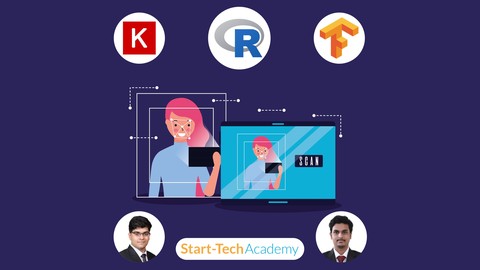
Image Recognition for Beginners using CNN in R Studio
Image Recognition for Beginners using CNN in R Studio, available at $64.99, has an average rating of 4.1, with 64 lectures, 6 quizzes, based on 314 reviews, and has 83605 subscribers.
You will learn about Get a solid understanding of Convolutional Neural Networks (CNN) and Deep Learning Build an end-to-end Image recognition project in R Learn usage of Keras and Tensorflow libraries Use Artificial Neural Networks (ANN) to make predictions This course is ideal for individuals who are People pursuing a career in data science or Working Professionals beginning their Deep Learning journey or Anyone curious to master image recognition from Beginner level in short span of time It is particularly useful for People pursuing a career in data science or Working Professionals beginning their Deep Learning journey or Anyone curious to master image recognition from Beginner level in short span of time.
Enroll now: Image Recognition for Beginners using CNN in R Studio
Summary
Title: Image Recognition for Beginners using CNN in R Studio
Price: $64.99
Average Rating: 4.1
Number of Lectures: 64
Number of Quizzes: 6
Number of Published Lectures: 60
Number of Published Quizzes: 6
Number of Curriculum Items: 70
Number of Published Curriculum Objects: 66
Original Price: $19.99
Quality Status: approved
Status: Live
What You Will Learn
- Get a solid understanding of Convolutional Neural Networks (CNN) and Deep Learning
- Build an end-to-end Image recognition project in R
- Learn usage of Keras and Tensorflow libraries
- Use Artificial Neural Networks (ANN) to make predictions
Who Should Attend
- People pursuing a career in data science
- Working Professionals beginning their Deep Learning journey
- Anyone curious to master image recognition from Beginner level in short span of time
Target Audiences
- People pursuing a career in data science
- Working Professionals beginning their Deep Learning journey
- Anyone curious to master image recognition from Beginner level in short span of time
You’re looking for a complete Convolutional Neural Network (CNN) course that teaches you everything you need to create an Image Recognition model in R, right?
You’ve found the right Convolutional Neural Networks course!
After completing this course you will be able to:
-
Identify the Image Recognition problems which can be solved using CNN Models.
-
Create CNN models in R using Keras and Tensorflow libraries and analyze their results.
-
Confidently practice, discuss and understand Deep Learning concepts
-
Have a clear understanding of Advanced Image Recognition models such as LeNet, GoogleNet, VGG16 etc.
How this course will help you?
A Verifiable Certificate of Completion is presented to all students who undertake this Convolutional Neural networks course.
If you are an Analyst or an ML scientist, or a student who wants to learn and apply Deep learning in Real world image recognition problems, this course will give you a solid base for that by teaching you some of the most advanced concepts of Deep Learning and their implementation in R without getting too Mathematical.
Why should you choose this course?
This course covers all the steps that one should take to create an image recognition model using Convolutional Neural Networks.
Most courses only focus on teaching how to run the analysis but we believe that having a strong theoretical understanding of the concepts enables us to create a good model . And after running the analysis, one should be able to judge how good the model is and interpret the results to actually be able to help the business.
What makes us qualified to teach you?
The course is taught by Abhishek and Pukhraj. As managers in Global Analytics Consulting firm, we have helped businesses solve their business problem using Deep learning techniques and we have used our experience to include the practical aspects of data analysis in this course
We are also the creators of some of the most popular online courses – with over 300,000 enrollments and thousands of 5-star reviews like these ones:
This is very good, i love the fact the all explanation given can be understood by a layman – Joshua
Thank you Author for this wonderful course. You are the best and this course is worth any price. – Daisy
Our Promise
Teaching our students is our job and we are committed to it. If you have any questions about the course content, practice sheet or anything related to any topic, you can always post a question in the course or send us a direct message.
Download Practice files, take Practice test, and complete Assignments
With each lecture, there are class notes attached for you to follow along. You can also take practice test to check your understanding of concepts. There is a final practical assignment for you to practically implement your learning.
What is covered in this course?
This course teaches you all the steps of creating a Neural network based model i.e. a Deep Learning model, to solve business problems.
Below are the course contents of this course on ANN:
-
Part 1 (Section 2)- Setting up R and R Studio with R crash course
-
This part gets you started with R.
This section will help you set up the R and R studio on your system and it’ll teach you how to perform some basic operations in R.
-
-
Part 2 (Section 3-6) – ANN Theoretical Concepts
This part will give you a solid understanding of concepts involved in Neural Networks.
In this section you will learn about the single cells or Perceptrons and how Perceptrons are stacked to create a network architecture. Once architecture is set, we understand the Gradient descent algorithm to find the minima of a function and learn how this is used to optimize our network model.
-
Part 3 (Section 7-11) – Creating ANN model in R
In this part you will learn how to create ANN models in R.
We will start this section by creating an ANN model using Sequential API to solve a classification problem. We learn how to define network architecture, configure the model and train the model. Then we evaluate the performance of our trained model and use it to predict on new data. Lastly we learn how to save and restore models.
We also understand the importance of libraries such as Keras and TensorFlow in this part.
-
Part 4 (Section 12) – CNN Theoretical Concepts
In this part you will learn about convolutional and pooling layers which are the building blocks of CNN models.
In this section, we will start with the basic theory of convolutional layer, stride, filters and feature maps. We also explain how gray-scale images are different from colored images. Lastly we discuss pooling layer which bring computational efficiency in our model.
-
Part 5 (Section 13-14) – Creating CNN model in R
In this part you will learn how to create CNN models in R.We will take the same problem of recognizing fashion objects and apply CNN model to it. We will compare the performance of our CNN model with our ANN model and notice that the accuracy increases by 9-10% when we use CNN. However, this is not the end of it. We can further improve accuracy by using certain techniques which we explore in the next part.
-
Part 6 (Section 15-18) – End-to-End Image Recognition project in R
In this section we build a complete image recognition project on colored images.We take a Kaggle image recognition competition and build CNN model to solve it. With a simple model we achieve nearly 70% accuracy on test set. Then we learn concepts like Data Augmentation and Transfer Learning which help us improve accuracy level from 70% to nearly 97% (as good as the winners of that competition).
By the end of this course, your confidence in creating a Convolutional Neural Network model in R will soar. You’ll have a thorough understanding of how to use CNN to create predictive models and solve image recognition problems.
Go ahead and click the enroll button, and I’ll see you in lesson 1!
Cheers
Start-Tech Academy
————
Below are some popular FAQs of students who want to start their Deep learning journey-
Why use R for Deep Learning?
Understanding R is one of the valuable skills needed for a career in Machine Learning. Below are some reasons why you should learn Deep learning in R
1. It’s a popular language for Machine Learning at top tech firms. Almost all of them hire data scientists who use R. Facebook, for example, uses R to do behavioral analysis with user post data. Google uses R to assess ad effectiveness and make economic forecasts. And by the way, it’s not just tech firms: R is in use at analysis and consulting firms, banks and other financial institutions, academic institutions and research labs, and pretty much everywhere else data needs analyzing and visualizing.
2. Learning the data science basics is arguably easier in R. R has a big advantage: it was designed specifically with data manipulation and analysis in mind.
3. Amazing packages that make your life easier. Because R was designed with statistical analysis in mind, it has a fantastic ecosystem of packages and other resources that are great for data science.
4. Robust, growing community of data scientists and statisticians. As the field of data science has exploded, R has exploded with it, becoming one of the fastest-growing languages in the world (as measured by StackOverflow). That means it’s easy to find answers to questions and community guidance as you work your way through projects in R.
5. Put another tool in your toolkit. No one language is going to be the right tool for every job. Adding R to your repertoire will make some projects easier – and of course, it’ll also make you a more flexible and marketable employee when you’re looking for jobs in data science.
What is the difference between Data Mining, Machine Learning, and Deep Learning?
Put simply, machine learning and data mining use the same algorithms and techniques as data mining, except the kinds of predictions vary. While data mining discovers previously unknown patterns and knowledge, machine learning reproduces known patterns and knowledge—and further automatically applies that information to data, decision-making, and actions.
Deep learning, on the other hand, uses advanced computing power and special types of neural networks and applies them to large amounts of data to learn, understand, and identify complicated patterns. Automatic language translation and medical diagnoses are examples of deep learning.
Course Curriculum
Chapter 1: Introduction
Lecture 1: Introduction
Lecture 2: Course Resources
Chapter 2: Setting Up R Studio and R crash course
Lecture 1: Installing R and R studio
Lecture 2: This is a milestone!
Lecture 3: Basics of R and R studio
Lecture 4: Packages in R
Lecture 5: Inputting data part 1: Inbuilt datasets of R
Lecture 6: Inputting data part 2: Manual data entry
Lecture 7: Inputting data part 3: Importing from CSV or Text files
Lecture 8: Creating Barplots in R
Lecture 9: Creating Histograms in R
Chapter 3: Single Cells – Perceptron and Sigmoid Neuron
Lecture 1: Perceptron
Lecture 2: Activation Functions
Chapter 4: Neural Networks – Stacking cells to create network
Lecture 1: Basic Terminologies
Lecture 2: Gradient Descent
Lecture 3: Back Propagation
Chapter 5: Important concepts: Common Interview questions
Lecture 1: Some Important Concepts
Chapter 6: Standard Model Parameters
Lecture 1: Hyperparameters
Chapter 7: Tensorflow and Keras
Lecture 1: Keras and Tensorflow
Lecture 2: Installing Keras and Tensorflow
Chapter 8: R – Dataset for classification problem
Lecture 1: Data Normalization and Test-Train Split
Lecture 2: More about test-train split
Chapter 9: R – Building and training the Model
Lecture 1: Building, Compiling and Training
Lecture 2: Evaluating and Predicting
Chapter 10: The NeuralNets Package
Lecture 1: ANN with NeuralNets Package
Chapter 11: R – Complex ANN Architectures using Functional API
Lecture 1: Building Regression Model with Functional AP
Lecture 2: Complex Architectures using Functional API
Chapter 12: Saving and Restoring Models
Lecture 1: Saving – Restoring Models and Using Callbacks
Chapter 13: Hyperparameter Tuning
Lecture 1: Hyperparameter Tuning
Chapter 14: CNN – Basics
Lecture 1: CNN Introduction
Lecture 2: Stride
Lecture 3: Padding
Lecture 4: Filters and Feature maps
Lecture 5: Channels
Lecture 6: PoolingLayer
Chapter 15: Creating CNN model in R
Lecture 1: CNN on MNIST Fashion Dataset – Model Architecture
Lecture 2: Data Preprocessing
Lecture 3: Creating Model Architecture
Lecture 4: Compiling and training
Lecture 5: Model Performance
Chapter 16: Analyzing impact of Pooling layer
Lecture 1: Comparison – Pooling vs Without Pooling in R
Chapter 17: Project : Creating CNN model from scratch
Lecture 1: Project – Introduction
Lecture 2: Data for the project
Lecture 3: Project in R – Data Preprocessing
Lecture 4: CNN Project in R – Structure and Compile
Lecture 5: Project in R – Training
Lecture 6: Project in R – Model Performance
Chapter 18: Project : Data Augmentation for avoiding overfitting
Lecture 1: Project in R – Data Augmentation
Lecture 2: Project in R – Validation Performance
Chapter 19: Transfer Learning : Basics
Lecture 1: ILSVRC
Lecture 2: LeNET
Lecture 3: VGG16NET
Lecture 4: GoogLeNet
Lecture 5: Transfer Learning
Chapter 20: Transfer Learning in R
Lecture 1: Project – Transfer Learning – VGG16 (Implementation)
Lecture 2: Project – Transfer Learning – VGG16 (Performance)
Chapter 21: Assignment
Lecture 1: Facial Mask detection
Chapter 22: Congratulations & about your certificate
Lecture 1: The final milestone!
Lecture 2: Congratulations & About your certificate
Lecture 3: Bonus lecture
Instructors
-
Start-Tech Academy
5,000,000+ Enrollments | 4.5 Rated | 160+ Countries
Rating Distribution
- 1 stars: 3 votes
- 2 stars: 7 votes
- 3 stars: 46 votes
- 4 stars: 107 votes
- 5 stars: 151 votes
Frequently Asked Questions
How long do I have access to the course materials?
You can view and review the lecture materials indefinitely, like an on-demand channel.
Can I take my courses with me wherever I go?
Definitely! If you have an internet connection, courses on Udemy are available on any device at any time. If you don’t have an internet connection, some instructors also let their students download course lectures. That’s up to the instructor though, so make sure you get on their good side!
You may also like
- Best Video Editing Courses to Learn in February 2025
- Best Music Production Courses to Learn in February 2025
- Best Animation Courses to Learn in February 2025
- Best Digital Illustration Courses to Learn in February 2025
- Best Renewable Energy Courses to Learn in February 2025
- Best Sustainable Living Courses to Learn in February 2025
- Best Ethical AI Courses to Learn in February 2025
- Best Cybersecurity Fundamentals Courses to Learn in February 2025
- Best Smart Home Technology Courses to Learn in February 2025
- Best Holistic Health Courses to Learn in February 2025
- Best Nutrition And Diet Planning Courses to Learn in February 2025
- Best Yoga Instruction Courses to Learn in February 2025
- Best Stress Management Courses to Learn in February 2025
- Best Mindfulness Meditation Courses to Learn in February 2025
- Best Life Coaching Courses to Learn in February 2025
- Best Career Development Courses to Learn in February 2025
- Best Relationship Building Courses to Learn in February 2025
- Best Parenting Skills Courses to Learn in February 2025
- Best Home Improvement Courses to Learn in February 2025
- Best Gardening Courses to Learn in February 2025






















